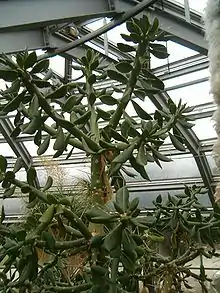| Quiabentia verticillata | |
|---|---|
 | |
| Scientific classification | |
| Kingdom: | Plantae |
| Clade: | Tracheophytes |
| Clade: | Angiosperms |
| Clade: | Eudicots |
| Order: | Caryophyllales |
| Family: | Cactaceae |
| Genus: | Quiabentia |
| Species: | Q. verticillata |
| Binomial name | |
| Quiabentia verticillata (Vaupel) Borg | |
| Synonyms | |
| |
Quiabentia verticillata is a species of cactus found from Bolivia to Argentina
Description
It is an erect woody succulent plant, growing tree-shaped or shrub-like and reaches heights of 2 to 15 meters. Its leaves, which are 4 to 5 centimeters long and up to 2 centimeters wide, are oval to lanceolate. Like many cactuses, it bears leaves which have become specialized as spines (protecting the plant from browsing by herbivores), as well as succulent leaf blades (soon deciduous). The spines up to 7 centimeters long actually consist of the stipules of the leaves. The stems are enlarged for water storage, and have a somewhat angular cross-section. The bright red flowers are 1.5 centimeters long.[2]

 Spine
Spine
Distribution
Quiabentia verticillata is common in Paraguay, Bolivia and northeastern Argentina in dry forests at altitudes of 350 to 2000 meters, infrequent in plain or mid-mountain habitats. It grows in dry sandy soils, typically found at the edge of fields, in wastelands, at the side of roads, and opportunistically in vineyards and orchards when they are not irrigated.
Taxonomy
The first description as Pereskia verticillata was made in 1923 by Friedrich Karl Johann Vaupel.[3] The specific epithet verticillata comes from Latin, means 'whorled' and refers to the shape of the branching of the shoots of the species. Curt Backeberg placed the species in the genus Quiabentia in 1936. Other nomenclature synonyms are Quiabentia verticillata (Vaupel) Borg (1937) and Grusonia verticillata (Vaupel) G.D. Rowley (2006).[4]
Cultivation and uses
Like most cactuses, it is a xerophyte, making it capable of growing in areas receiving very little rainfall. It has a laterally extensive, shallow root system.
References
- ↑ "The IUCN Red List of Threatened Species". IUCN Red List of Threatened Species. 2010-09-22. Retrieved 2023-10-15.
- ↑ Anderson, Edward F.; Eggli, Urs (2005). Das grosse Kakteen-Lexikon (in German). Stuttgart (Hohenheim): Ulmer. p. 557. ISBN 3-8001-4573-1.
- ↑ "Au Cactus Francophone :". Au Cactus Francophone (in French). Retrieved 2023-10-15.
- ↑ "Au Cactus Francophone :". Au Cactus Francophone (in French). Retrieved 2023-10-15.
This article draws from , , and on the internet, which were accessed in the version of 27 July 2006.
External links
 Media related to Quiabentia verticillata at Wikimedia Commons
Media related to Quiabentia verticillata at Wikimedia Commons Data related to Quiabentia verticillata at Wikispecies
Data related to Quiabentia verticillata at Wikispecies
